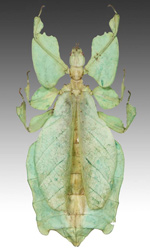Insect Dreams – Collecting Bugs and Butterflies
PRIMITIVE - Friday, July 17, 2015 |
|
By Misaki Imagawa
Hello Bug Sale! My lips have been curled in a perpetual state of fear for the past few days while researching PRIMITIVE’s extensive collection of bugs and butterflies. It is one thing to see pictures in books or on the web, but quite another to see beetle exoskeletons, tarantulas twice the size of my hands, giant centipedes and scorpions up close and personal. To compound matters, Glen Joffe told me a story about being served a plate of noodles and scorpions while on a trip to China. It didn’t do much for my sleep. Pictures of all sorts of insect delicacies appeared in my dreams...I mean nightmares.
 |
|
I do admit, though, it really isn't horrifying. In fact, most of the specimens in the sale are simply beautiful. In particular, I find the butterflies almost magical with their colorful wings outspread. Some refer to their wings as 'nature's canvas.' The leaf and stick insects make you marvel at the intricate workings of the natural world; and in terms of presentation, the delicate curves of tiny antennae speak to the dedicated care that went into preserving and showcasing these specimens. Knowing that all the insects are natural in color and have not been treated artificially in any way enhances one’s appreciation of nature’s handiwork. Some of the smaller beetles, presented colorfully side by side are so beautiful they demand to be considered sculptural art pieces.
Whether we like it or not, insects are not going anywhere. They make up over two-thirds of all known living organisms – approximately 1.3 million species; and who knows how many are still undocumented, waiting to be discovered. They have existed since or even before the time of dinosaurs, survived asteroid collisions, ice ages, and even thwarted human efforts to destroy them. Cockroaches and scorpions can even walk away from ground zero of nuclear bomb sites unaffected – talk about indestructible design!
 |
|
From museum collections to university labs to the shelves and walls of living rooms, scientists and collectors alike maintain insect collections for study and enjoyment. Due to the small size of most insects and the sheer variety of look-alikes and subspecies, creating a collection is the only way to inspect their differences in minute detail. Many university classes make it a requirement for students to go out and start their own collections as the best way to educate and learn about these small life forms that have greatly impacted human history time and again.
 |
|
Today, insect collecting is an art; no different from any other form of collecting. Some of the earliest collections of insects were presented around the 17th century in European curiosity cabinets, displayed next to exotic plant species and prehistoric fossils. These curiosity cabinets featured unusual, yet fascinating objects that appealed to scientists and casual observers alike. In a sense, curiosity cabinets were the precursors of modern day museums, and bugs, being an essential part of the natural world could not be ignored. Even so, it wasn’t until the 19th and 20th centuries that bug collecting, if you will, really caught on as a hobby, and bugs in general, really began to be appreciated strictly for their extraordinary beauty. Insects have a seductive pull on our aesthetic sensibilities, and in some cases, our morbid curiosities.
 |
 |
The presentation of each individual insect is an important aspect of entomological collections. Just as the quality of specimens may vary, so does presentation quality. It is one thing to present drawers of insects for scientific study at a museum and quite another to present them as natural art intended to be appreciated and admired. High quality collector’s pieces bred at sustainable insect farms should be displayed in a way that preserves the natural quality of the specimens and shows them as fine art. Specimens must be properly preserved and ultimately arranged in a visually pleasing and natural manner. Be it a group of multicolored beetles, a sleek dragonfly, a mighty scarab, radiant butterfly or undulating centipede, every creature of nature contains inherent beauty. At PRIMITIVE, these specimens are framed and floated behind glass so they can be appreciated as a high form of natural art. When finally hung on the wall they provide an alluring edge to any room or environment. They can even convince me to overcome my fear and say, "wow, that's an incredible work of art."

|
|
Download this Article: Insect Dreams.pdf